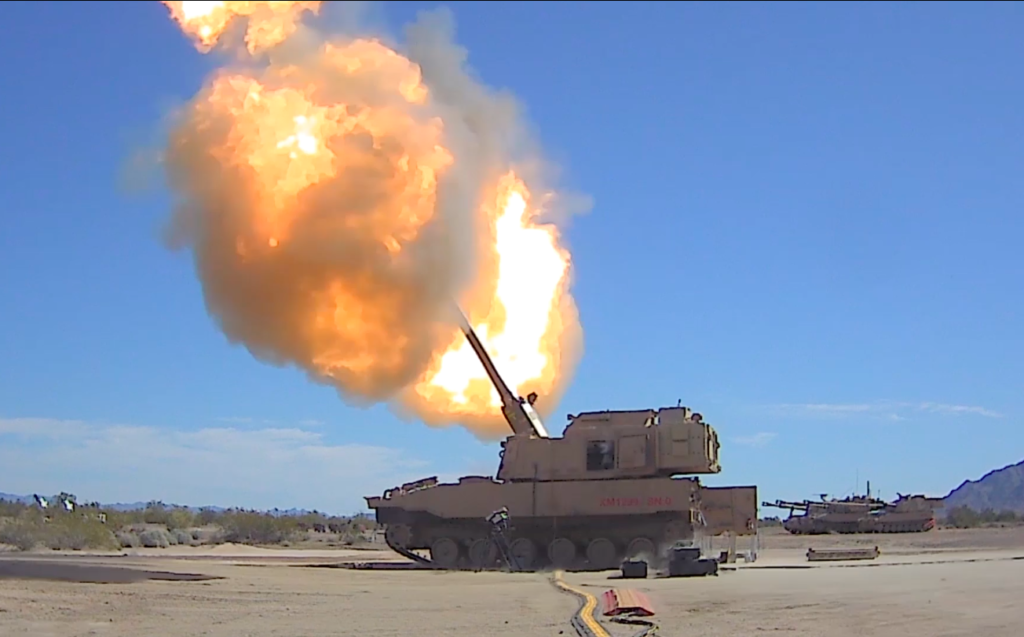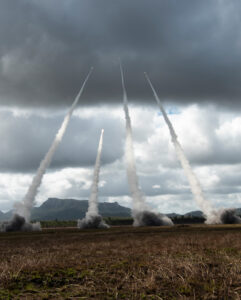
The prototype M1299 ERCA armoured howitzer test-firing at Yuma Proving Ground on March 6, 2020.
WASHINGTON: The Army’s AI-driven battle networks are taking a world tour of live-fire wargames.
Having wrapped up an exercise in Washington State last month with the Army’s experimental Multi-Domain Task Force, the AI wargames will head to Europe in May and to the Pacific in July, before returning to the US for the climactic Project Convergence exercises in the fall.
The goal of these wargames: stress-test AI algorithms and network connections in conditions close to combat as real soldiers fire live weapons like HIMARS rocket launchers, M777 howitzers, and (in Project Convergence) prototype ERCA cannon and PrSM missiles. By putting people, electronics, and algorithms through their paces in realistic conditions, the Army hopes to figure out what slows down the kill chain and then target R&D investments to accelerate it.

William “Willie” Nelson
Stopwatches & Software
“We had data collection managers onsite with stopwatches [timing] every step of the way,” said Willie Nelson, director of Assured Precision Navigation & Timing (APNT) at Army Futures Command. “How long does it take the data to get… from Point A to Point B to C?
“You start laying out all of these steps that it takes in this entire kill chain, and then you start putting time and data formats to those… and it becomes fairly obvious of where the real clog in the pipe is,” Nelson told me in an interview. “It provides an opportunity to really target where our investment needs to go. Where’s your real biggest bang for your buck? The dollars are so short…we want to make sure that we’re putting those on the real hard problems that have the highest payoff,” Nelson said. “If we’ve got an area here that takes a significant amount of time, if we invest… through algorithm development, crew training, or other types of processes, can we cut that time down?”
The goal is to replace human beings who manually enter data with direct machine-to-machine transmission, he said – all without replacing human judgment.
“Every instance of fat-fingering into a machine that you can eliminate, [that] eliminates risk, human error, and in some cases generally speeds up the system,” he told me. “Now, you don’t want it to be completely autonomous; you need commanders in the loop at the right places. But if you can get the data to present to a commander in a way that they can quickly make decisions and not have to hand-jam that in, that’s a win.”
The experimental Army system sucks in data from satellites, drones, and other sources in a host of formats: visual images, radar returns, radio-frequency emissions. That data gets combined in a jury-rigged ground terminal – a surrogate for the new TITAN terminal entering prototype in 2022 – running AI software known as Prometheus and SHOT. These programs correlate the different types of data, identity potential targets, and nominate the best available weapon to take them out, based on the commander’s customized priorities and preferences. A human must then approve the transmission of orders to fire.
The focus is on quickly presenting useful, well-organized information to commanders’ to help them make better decisions faster. That requires pulling data from systems that were never designed to work together in formats that were never meant to be compatible.
“What we’re doing really well and what we’re doing at speed is the ability to take that data in its multiple formats that worked really well for those individual communities,” Nelson told me. Today, he said, that requires translator systems to convert data from one format to another. In the future, however, he said, the Army wants to move to a single common set of standards that make everything compatible from the start.
“But that’s an evolutionary thing. You can’t just say, ‘Okay, everybody starting tomorrow, everybody has to have this standard,’” Nelson told me. “You’ve got to find a way to bring in the legacy systems, marry those up and communicate… with the newer platforms.”

American HIMARS multiple rocket launchers during a live-fire exercise in Australia, part of the Talisman Saber 2019 wargames.
Five Wargames
To assess what really works, it’s vital to see how the experimental AI technology is used by real troops in real live-fire missions. “That’s really the advantage that we’ve got now, is an ability to get off PowerPoint and really get it into the practical world…using real soldiers and operators in the field,” Nelson told me.
The Army is doing five major live-fire exercises with the AI networks this year. The first was at Fort Lewis in March, with the experimental Multi-Domain Task Force and I Corps, which oversees Army forces in the Pacific.
“We were up there last month for that exercise with them and it was a huge success,” Nelson said. In terms of participating personnel, he told me, “it was probably the most heavily supported exercise we’ve had. We’re headed to Europe next month in May,” Nelson went on, building on last year’s wargames in Germany. “We’ll have more surrogate targets, we’ll have more operational units involved, and we’ll be moving the data at speeds we just haven’t never moved before. We’ll bring additional sensors into the picture that we haven’t had before. So it’ll be probably our biggest test of the year.
Then it’s off to the Pacific, where Nelson had hoped to hold wargames last year but had to cancel due to COVID. So this year, he said, “we’ll have two different events out there.”
“Then,” he concluded, “we’ll be resetting and coming back to the States and getting ready to support the 82nd [Airborne Division] and Multi-Domain Task Force in executing the sensor-to-shooter testing that’ll happen at a Project Convergence at both White Sands and Yuma [around] October, November.”






















